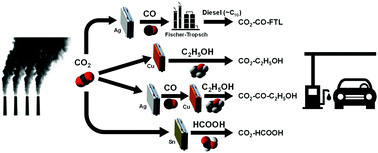当前位置:
X-MOL 学术
›
Energy Environ. Sci.
›
论文详情
Our official English website, www.x-mol.net, welcomes your
feedback! (Note: you will need to create a separate account there.)
A comparative technoeconomic analysis of pathways for commercial electrochemical CO2 reduction to liquid products†
Energy & Environmental Science ( IF 32.4 ) Pub Date : 2018-04-04 00:00:00 , DOI: 10.1039/c8ee00097b Joshua M. Spurgeon 1, 2, 3, 4 , Bijandra Kumar 4, 5, 6, 7
Energy & Environmental Science ( IF 32.4 ) Pub Date : 2018-04-04 00:00:00 , DOI: 10.1039/c8ee00097b Joshua M. Spurgeon 1, 2, 3, 4 , Bijandra Kumar 4, 5, 6, 7
Affiliation

|
Electrochemical reduction of CO2 to fuels and chemicals is currently a focus of significant research effort as a technology that can simultaneously mitigate greenhouse gas emissions while storing renewable electricity for use on demand. Liquid products are particularly desirable as an easily storable and portable energy-dense form. To be widely implemented, CO2 electroreduction technologies must be able to produce chemicals at costs that are economically competitive with existing commercial prices. In this work, four possible routes to the electrochemical synthesis of liquid products from CO2 derived from post-combustion flue gas were compared with one consistent approach to technoeconomic analysis. In the first case, diesel fuel was produced from electrosynthesized CO plus H2 to make syngas which was subsequently converted through the Fischer–Tropsch process. Liquid ethanol was modeled through two comparable approaches, a one-step electrolysis and a two-step cascade electrolysis. Lastly, the direct electrosynthesis of formic acid from CO2 was considered. In the base case scenarios established on current state-of-the-art CO2 reduction research, none of the processes were modeled to be competitive with present fuel prices. High capital expense for the electrolyzer units was the primary limiting factor. With conceivable improvements in an optimistic scenario, the diesel process was projected to have the best pathway to making cost-effective fuels, while ethanol would be prohibitively expensive without major improvements to the present electrosynthesis performance. Formic acid, though projected to be expensive relative to its stored energy content, was projected to have perhaps the simplest pathway to production at costs competitive with its commercial bulk price. In each case, the levelized cost of the liquid product was most strongly influenced by parameters that affect the electrolyzer capital cost (i.e., current density, faradaic efficiency, and cost per electrode area).
中文翻译:

商业电化学将CO 2还原为液体产品的途径的比较技术经济分析†
电化学还原燃料和化学制品中的CO 2目前是一项重要的研究重点,因为该技术可同时减少温室气体排放,同时存储可再生电力供按需使用。液体产品作为易于储存和便携式的能量密集形式是特别理想的。为了广泛实施,CO 2电解还原技术必须能够以与现有商业价格在经济上具有竞争力的成本生产化学品。在这项工作中,从CO 2电化学合成液体产物的四种可能途径将燃烧后烟气中产生的烟气与一种一致的技术经济分析方法进行了比较。在第一种情况下,是由电合成的CO加H 2产生柴油,以生产合成气,然后通过费-托工艺转化为合成气。液体乙醇通过两种可比较的方法进行建模,即一步电解和两步级联电解。最后,考虑了由CO 2直接电合成甲酸。在基本情况下,以当前最先进的CO 2为基础减排研究中,没有一个模型可以模拟出与当前燃料价格具有竞争力的过程。电解装置的高资本支出是主要限制因素。在乐观的情况下,可以想象得到的改进,预计柴油工艺将成为生产具有成本效益的燃料的最佳途径,而如果不对当前的电合成性能进行重大改进,乙醇将是昂贵的。甲酸虽然相对于其储存的能量含量而言价格昂贵,但据推测可能是最简单的生产途径,其成本与其商业批量价格具有竞争力。在每种情况下,液体产品的平准化成本都受到影响电解槽资本成本的参数的最大影响(即,电流密度,法拉第效率和每电极面积的成本)。
更新日期:2018-04-04
中文翻译:

商业电化学将CO 2还原为液体产品的途径的比较技术经济分析†
电化学还原燃料和化学制品中的CO 2目前是一项重要的研究重点,因为该技术可同时减少温室气体排放,同时存储可再生电力供按需使用。液体产品作为易于储存和便携式的能量密集形式是特别理想的。为了广泛实施,CO 2电解还原技术必须能够以与现有商业价格在经济上具有竞争力的成本生产化学品。在这项工作中,从CO 2电化学合成液体产物的四种可能途径将燃烧后烟气中产生的烟气与一种一致的技术经济分析方法进行了比较。在第一种情况下,是由电合成的CO加H 2产生柴油,以生产合成气,然后通过费-托工艺转化为合成气。液体乙醇通过两种可比较的方法进行建模,即一步电解和两步级联电解。最后,考虑了由CO 2直接电合成甲酸。在基本情况下,以当前最先进的CO 2为基础减排研究中,没有一个模型可以模拟出与当前燃料价格具有竞争力的过程。电解装置的高资本支出是主要限制因素。在乐观的情况下,可以想象得到的改进,预计柴油工艺将成为生产具有成本效益的燃料的最佳途径,而如果不对当前的电合成性能进行重大改进,乙醇将是昂贵的。甲酸虽然相对于其储存的能量含量而言价格昂贵,但据推测可能是最简单的生产途径,其成本与其商业批量价格具有竞争力。在每种情况下,液体产品的平准化成本都受到影响电解槽资本成本的参数的最大影响(即,电流密度,法拉第效率和每电极面积的成本)。











































 京公网安备 11010802027423号
京公网安备 11010802027423号